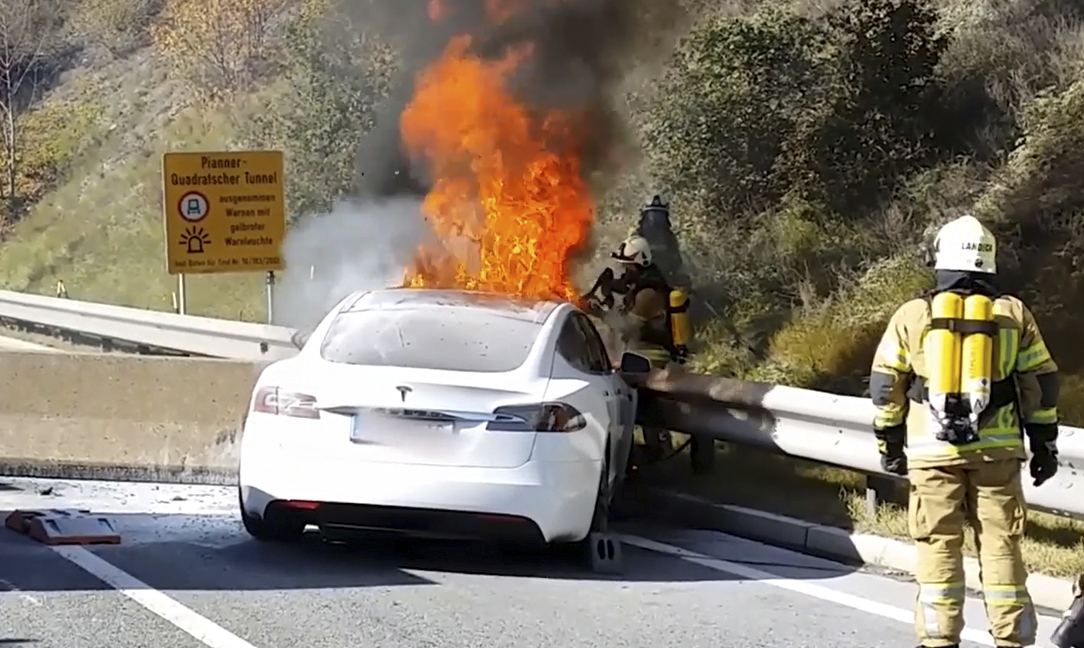Up to 130 kW Mobile charging for electric cars arrives in Spain
Hyundai interview: "Gasoline at two euros benefits the electric car"
Simpler to manufacture and due to their technology, electric cars are, however, more difficult to put out when they catch fire.
The key is in its batteries, which -due to their chemistry and construction- not only require more means to turn it off, but can burn again later.
That was not the case of two battery cars that burned in a Madrid garage last week.
But yes the one of a Tesla Model S that was reduced to ashes in Sacramento.
Three weeks in the scrapyard
The car, in fact, had been in the scrapyard for three weeks when it caught fire.
In its extinction, it was necessary to spend more than 17,000 liters of water and create a kind of pool to submerge the batteries
that, even so, caught fire again.
"We weren't expecting so many challenges," explained Parker Wilbourn, the Sacramento Fire Captain.
Neither did the Austrian professionals who attended the fire of another
Tesla Model S that had crashed into some barriers.
Up to five vehicles and 35 professionals were necessary to control the situation.
'Thermal runaway'
There are two main reasons for a car to catch fire after an accident:
a short circuit inside it or a perforation.
To avoid this, they are usually embedded in a protective structure.
In addition, they are placed in the central part of the car floor, which is the least exposed in the event of a crash.
A Tesla Model S on fire in Austria
It may also be that the cells are poorly designed,
like the LG cells of the thousands of Chevrolet Volts that the brand had to review in the US.
The Korean supplier assumed almost all the costs of the recall (about 1,900 million dollars), while
Chevrolet warned users of unrepaired cars to park them outdoors and at least 15 meters
from other vehicles.
Less risk than combustion
Although that is not normal.
On the contrary.
According to data from AutoinsuranceEZ based on accident statistics in the US,
100% electric vehicles have a fire risk of 0.3%, a figure that rises to 1.5% in combustion models
and 3.4% in the hybrids that carry the two technologies.
Chevrolet reviewed thousands of Bolt units due to a failure in LG batteries
The risk is triggered if any of the mentioned damages are suffered.
Then, inside the battery, the temperature begins to rise in a
phenomenon called 'thermal runaway' that feeds back.
That is, the very rise in heat causes it to increase faster and faster,
being able to reach 600 degrees and start to burn.
Various toxic gases are also given off in the process.
latent danger
The serious thing is that this phenomenon can be triggered hours or days after the accident,
as could happen in Sacramento.
Also, emergency services are used to dealing with electrical fires, but not when they happen in a car.
Hence the importance of automatic deactivation systems for the battery and high voltage circuits.
And to offer clear instructions, either through the so-called rescue sheet or through visible indications on the bodywork, on where to cut or not when, for example, the injured have to be released.
Specific training courses
In this sense,
General Motors will give specific training courses for firefighters.
And Renault has designed the batteries of the new Mégane e-Tech in collaboration with these professionals so that they can be switched off in minutes.
At the end of 2020, the US authorities recommended that the manufacturers of this type of car prepare a first aid manual on how to act in the event of a fire.
As of early June,
only eight of the 22 builders involved had fully integrated those recommendations.
The Model 3, sales leader in Spain
With electrified cars (100% electric and plug-in hybrids), one can also speak of one of lime and one of sand in terms of sales.
They continue to gain weight and already account for 9.3% of registrations since January.
However, barely
38,124 passenger cars and 4x4s were sold,
when the projections of the Integrated National Energy and Climate Plan for this decade would make
it necessary to reach 120,000 vehicles this year;
or 60,000 in the first half.
Here, we find that the Model Tesla 3 is the favorite of
100% electric
buyers , in the month and in the accumulated, with 1,587 units shipped since January.
It is seconded by the
Kia Niro,
with 1,055 cars between January and June.
In the PHEV, the first place corresponds to the Peugeot 3008,
both in June and in the semester, where it accounts for 1,679 units.
The Mercedes-Benz GLC is second, with 1,044 vehicles.
Conforms to The Trust Project criteria
Know more
Environment
Electric cars
Hybrid cars

